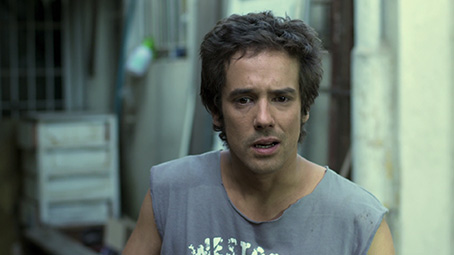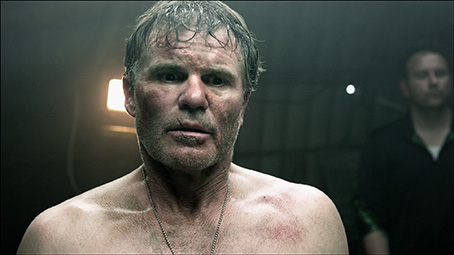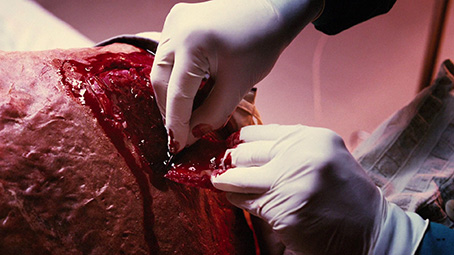|
Anthology horror movies are notoriously tricky beasts. Coming up with enough material for one good story is tough enough, but four or five? Good luck, mate. On top of that you've got only a fraction of the running time of the average feature to work with on each. That's twenty to thirty minutes to bond your audience to characters they've only just met and spin a gripping yarn, preferably one with a sting in its tale. Park Chan-wook did it with his segment in Three... Extremes by sticking to a formula he'd honed to perfection. Amicus did it with Tales From the Crypt by adapting some of the best stories from EC horror comics. And Creepshow pulled it off with aplomb because it was directed by George Romero and written by Stephen King.
Usually, however, the quality of the stories tends to vary quite a bit, particularly if each is handled by a different filmmaker. So imagine a feature film comprised not of four or five short stories but twenty-six, making the average running time of each somewhere between two and six minutes. It's the sort of project that media lecturers set for their students, the difference here being that the students in question are all established filmmakers, many of whom have already made their name in the genre. They've also got a bigger budget to work with than their academic equivalent, which should ensure that even the less adventurous contributions have a degree of technical polish. Asked to select a letter of the alphabet (and be assigned one if they didn't) and come up with an alphabetically and thematically appropriate title, the filmmakers were each given a $5,000 budget and complete artistic freedom, the only stipulation being that the film should have something to do with death and end on a plain red screen.

Clearly the standard approach to character building and storytelling has no place here, and with only a few minutes to spin the yarn, the results are more likely to play like a skit than a short film in the usual sense. It's the horror equivalent of a verbal gag where the build-up is all about the punch line, the final twist that provides reasoning for what has gone before. Having said that, not all of the contributors here have adopted this approach. A small few have chosen to simply create a death-themed sequence and leave it to us to unravel their significance or meaning, while the Japanese contributors have opted to use the project to go a little nuts.
The results, as you might expect, are widely variable in their approach, their originality and their overall effectiveness, but the brief running time of each does mean that if one segment disappoints then you won't have to wait long until another comes to the rescue. Which assumes, of course, that they don't all get up your nose, a nasal invasion that has clearly afflicted some (re-) viewers. Personally, I went in with certain protective preconceptions: that character engagement would be superficial at best; that storylines would be lacking in narrative complexity; and that I'd be watching notebook sketches rather elaborate paintings, if you get my drift. I didn't expect to be chewing my fingernails in fear, but I did hope to be surprised, maybe given the odd jolt and be intermittently entertained. That I was likely to be disappointed by some of the films was a bit of a given, but I also hoped to be just a little bit impressed by some of the others (your film taste would have to be pretty damned broad to be thrilled by them all). In that respect, the project lived both up and down to my expectations. Scary it is not. The quality of the films goes up and down like the temperature graph of a feverish patient. A few are shackled by cultural components that do not translate well to an international audience. A couple even require the assistance of the extra features to fully appreciate and even make sense of. But nestled within the pack are a few worthy works and a couple of minor gems. And while not always fully engaged, I was never bored.
There's definite first viewing fun to be had from wondering what will come next and discovering only at the end just who was in the director's chair. Opinions will vary – and remember guys, they are just opinions – but a couple of names that I expected to do well here didn't really deliver (just about everyone has singled out House of the Devil's Ti West as the worst offender here), while others I had no specific expectations for really impressed. To get the most out of the project definitely requires a level of tolerance and open-mindedness that is borderline alien to some genre devotees. Those expecting twenty-six similarly toned films are on to a non-starter, as are those who automatically assume that they'll be watching an all-out horror film simply because it has the word "death" in the title (buy me a pint and I'll tell you about the friend who bought a DVD of Death in Venice on the assumption that it was another Don't Look Now).

The problem with discussing the individual films in any detail is that in almost all cases a single sentence description will cover everything but the final reveal, which the outline will inevitably hint at anyway. Complicating matters is that the words chosen by a couple of the filmmakers also function as final twist spoilers, something recognised in the placement of the individual titles at the end rather than the start of each segment. It's thus best not to know all of the titles in advance, but avoiding exposure to them is actually trickier than you might think. They were listed as part of the press release sent out to promote this very disc (one we faithfully reproduced in its entirety, I might add), as well as on the film's IMDb page and on the chapters menu on this very disc. It's for this reason that I'll be referring by a couple of the segments by their assigned letter only. All clear? Good.
I've decided to briefly cover the individual films in the section below, making it easy to skip past if you want to go in cold, which would be my preferred approach. But if you want to get a flavour of what you are in for and which particular films tickled my own genre fancy, then I promise to keep descriptions brief and sidestep major spoilers. On those rare occasions where the title itself acts as a giveaway, I'll omit the chosen word, as in A is for...
A is for... (Spain)
A prime example of the punch line (and the title) revealing the purpose of previously inexplicable behaviour, in this case the repeated attempts of a woman to violently murder a man in his bed. It's a neat enough gag from TimeCrimes director Nacho Vigalondo, and certainly gets things off to an appropriately grisly start.
B is for... (Mexico)
A too-familiar tale from Cold Sweat director Adrian Garcia Bogliano, in which a story told by adults to scare kids into obedience turns out to have a basis in truth.

C is for Cycle (Chile)
A Twilight Zone-ish mystery with Lynchian overtones and no clear explanations from Mirageman director Ernesto Díaz Espinoza. The handling is still suggestively sinister.
D is for Dogfight (USA)
A professional brawler faces his toughest opponent at a fight club with a difference. An intriguing idea (from Deadgirl director Marcel Sarmiento) whose super-stylishly presentation and satisfying punch line make it one of the best segments here. Concerned animal lovers would do well to watch the extra features before lodging their protests.
E is for Exterminate (USA)
A man does battle with a CG spider with unsurprising though still unpleasant results. Directed by Roman's Angela Bettis.
F is for Fart (Japan)
A spectacularly silly tale of embarrassing bodily functions from Robo Geisha director Iguchi Noburu, presented in the manner of a dreamy schoolgirl lesbian fantasy and apparently inspired by the Fukushima nuclear disaster.
G is for Gravity (Australia)
The Reef director Andrew Traucki returns to water for a content-thin but oddly troubling sequence shot entirely from the viewpoint of the sole protagonist. Apparently based on an actual incident, though I'd love to know what Traucki spent his $5,000 budget on.
H is for Hydro-Electric Diffusion (Norway)
A completely barmy live-action Looney Tunes piece from Norwegian Ninja director Thomas Malling in which a WW2 British bulldog watches an erotic dance by a German fox who is not what she seems.

I is for Ingrown (Mexico)
A man injects an unspecified household chemical into a woman he has tied up in his bathtub. A tonally disturbing but twist-free short from We Are What We Are director Jorge Michel Grau, one that plays like an extract from a longer film and whose grim inspiration is revealed on the commentary.
J is for Jidai-Geki (Japan)
A samurai preparing to behead a comrade who is committing sepuku has his concentration repeatedly disturbed by peculiar visions. Initial intrigue slips into cartoon daffiness as the piece progresses, perhaps not surprising given that director Yamaguchi Yudai was also partly responsible for Yakuza Weapon.
K is for Klutz (Denmark)
A woman is pestered by the affectionate results of a recent bowel movement in a nicely animated piece from Princess director Anders Morgenthaler.
L is for Libido (Indonesia)
A taboo-busting Indonesian short from Macabre co-director Timo Tjahjanto in which strapped-down men compete in a lethal competition in which they are required to masturbate for their lives to increasingly extreme floorshows. I liked this one.
M is for... (USA)
A surprisingly weak entry from House of the Devil director Ti West. The story is so thin that there's nothing I can say that won't tell you everything except the ending, which you'll probably guess anyway.
N is for Nuptials (Thailand)
An age-old gag involving a talking parrot has predictable consequences in this cheerful but lightweight effort from Shutter director Banjong Pisathanakun.

O is for Orgasm (Belgium)
Sex and death are nail-gunned together in a segment that's every bit as hyper-stylised and giallo-influenced as Amer, the visually striking but emotionally ice-cold debut feature from co-directors Bruno Forzani and Héléne Cattet. Intermittently it plays like one of those poncier perfume or aftershave commercials, or that currently screening one where a woman wanks off to ice cream.
P is for Pressure (UK)
One of the longest segments here, from Red, White & Blue director Simon Rumley, is a worthy enough tale of poverty-enforced desperation in the slums of Suriname, but is more social realist drama than horror.
Q is for Quack (USA)
The first of two American segments in which the director (Adam Wingard in this case) wrestles on-screen with the problem of what to do with his assigned letter. The eventual consequences of his deliberations are hardly original but the piece itself is rather nicely handled.
R is for Removed (Serbia)
Strips of skin are flayed from the back of a shackled burns victim and chemically processed to reveal 35mm film strips buried within. A grisly and tonally disturbing espionage horror with a strong hint of Cronenberg from A Serbian Film director Srdjan Spasojevic.
S is for Speed (UK)
A Troma-esque grindhouse piece from Doghouse director Jake West, one whose big-breasted female desperadoes, flame-throwing weaponry, nitro-fuelled car chase and seemingly indestructible, gravelly voiced bad guy are justified in the nicely timed reality-snap climax.
T is for Toilet (UK)
A potty-trained young boy faces the horror of using a toilet for the first time in Lee Hardcastle's amusing and typically rough-and-ready Claymation piece.
U is for Unearthed (UK)
The second segment shot entirely from the point of view of a single protagonist plays a little like the climax from a longer film, but is meatily handled by Kill List and A Field in England director Ben Wheatley.

V is for Vagitus (USA)
A real surprise this one. I wasn't that huge a fan of director Kaare Andrews debut feature Altitude, but here he delivers a slickly handled and tightly structured science fiction actioner with some well timed twists. Andrews' clear talent for physical and visual effects work (see the accompanying extras for more on this) ensures that his segment belies its $5,000 budget and for my money is just about the most satisfyingly complete short film here. Bravo.
W is for WTF! (USA)
Metalocalypse director Jon Schnepp cheats a little on his letter in order to unleash an explosion of low budget audio-visual insanity employing everything from animation and five-way split screen to green screen and physical gore effects to throw everything that popped into his head onto the screen, presumably after he'd taken a man-sized cocktail of hallucinogenic drugs.
X is for XXL (France)
An obese woman bows to societal and advertising pressure and embarks on her own drastic weight loss program in a segment from Frontier(s) and Hitman director Xavier Gens. The frequency and directness of the early taunting she suffers is a bit of a stretch (though we are talking severely compressed narrative here), but it builds to the most satisfyingly horrific climax in the entire anthology.
Y is for Youngbuck (Canada)
A creepy school caretaker takes one of the young pupils hunting and teaches him more than just how to kill a deer in a stylised revenge piece from Hobo With a Shotgun's Jason Eisener. The heavily tinted slo-mo visuals and lack of diegetic sound do make it play like a twisted music video, which it turns out was Eisener's intention.
Z is for Zetsumetsu (Japan)
Tokyo Gore Police director Nishimura Yoshihiro goes absolutely bugshit with no regard for taste barriers or audience comprehension, a wild potpourri that includes explicit nudity, socio-political satire, a Japanese Dr. Strangelove, an oversized phallus with a switchblade tip, a woman who uses her vagina to launch vegetables like missiles, and a whole lot more. Blink twice and you'll miss the 9/11 attacks and the 3/11 earthquake recreated as tattoos on wobbling breasts and buttocks.
A few years ago a project like this would have sent many of the filmmakers scurrying to low-band formats like mini-DV to avoid spending the entire budget on camera hire, but all of the shorts here have been shot on decent quality HD, a mixture of RED Camera visual precision and surprisingly pleasing Canon DSLR imagery. This does result in some occasional banding and the odd compression artefact, and having twenty-six films with differing visual styles ensures that the imagery varies widely on a film-by-film basis. Save for a few occasions when lighting or post-production work have made their mark, the results are generally impressive, with a good contrast range, solid black levels, rich colour reproduction and often crisp detail, though the RED Camera footage does tend to shine brighter here (check out the facial close-ups in Dogfight or the deer's eye in Youngbuck). The framing for the most part is 1.78:1, though Vagitus was shot 2.35:1.

The DTS-HD Master Audio 5.1 surround soundtrack is consistently well recorded and mixed. All of the films have and excellent clarity and range, though some make more ear-catching use of the sound stage and lower frequencies – the thunderous climax of A..., the beefy music of Dogfight, the deep throbbing bass of Ingrown, the lively surround work in Unearthed, the multi-directional punch of gunfire and explosions in Vagitus, and the unsettling screech and rumble of the score in XXL.
Commentary
What we really wanted here is for each of the directors to comment individually on their own films, which is happily what we get. There's even an intro and end cap by the project's producers Ant Timpson and Tim League and a useful breakdown of the main title sequence by its designer Aaron Becker. Like the films themselves, the commentaries vary a little in what they deliver but all have points of interest: Adrian Garcia Bogliano suggests that some details of his segment will only make sense to a Mexican audience; Ernesto Díaz Espinoza tells us "I'm a big fan of David Lynch, as I imagine all of you are"; Iguchi Noburu assures us that he wanted F for Fart to have a similar tone to Picnic at Hanging Rock (seriously?); Jorge Michel Grau provides the grim social-political background to his choice of subject matter; Timo Tjahjanto reveals that his make-up effects man walked after taking offence at the content of his segment; Srdjan Spasojevic elects not to comment on the film but narrate the thoughts of his main character; Jason Eisener tells an amusing road-kill story; Nishimura Yoshihiro confirms that he was determined to include material that would be censored in Japan. My favourite quote of all came from new father Kaare Andrews, who on hearing of the project contacted the producers and told them: "I've got this baby – let me in the movie and I'll decapitate it for you." There's also plenty of info on the casting and technical aspects.
A is for... Oil Burns Visual Effects (1:09)
A useful step-by-step breakdown of how a specific visual effect was achieved. This also reveals what the HD image looked like before it was processed in post-production.
B is for... Making of (2:55)
A brief but still engaging peek behind the scenes of what really does look like a low budget shoot. Which it was, of course.
C is for Cycle – Deleted Scenes (3:27)
Three edited scenes that we can presume were cut purely to bring the running time of the segment down. All are interesting if you've watched the segment first. Which you did, didn't you?

D is for Dogfight – Making Of (6:56)
A look behind the scenes of one of the more visually stylised films in the collection, fascinating for the dog training footage and how much less dramatic the lighting looks compared to in the finished film.
F is for Fart – Behind the Scenes (9:45)
A fun look at the shoot of one of the dafter segments in film, particularly the crew's bargain basement approach to one particular physical effect (I really am trying to avoid spoilers here) and the spanking pace at which director Iguchi Noburu appears to work.
H is for Hydro-Electric Diffusion
Behind the Scenes (6:39) features footage of the making of Thomas Malling's oddball wartime parody piece that has been edited to precisely match the action and pace of the film, with further footage playing under the long end credits sequence. The Making of Bertie the Bulldog & Frau Sceisse (4:46) is a step-by-step look at the creation of the lead characters, from concept sketches to final make-up and prosthetics. Finished Short vs. Behind the Scenes (6:43) plays the behind the scenes featurette from above side-by-side with the finished short, which is probably why the former was cut that way in the first place.
I is for Ingrown – Making Of (6:42)
Brief snippets from what feels like a far longer making-of video mixed with stills of the shoot and post production work.
J is for Jidai-Geki – Behind the Scenes (6:29)
A structurally scattershot but still interesting look at what comes across as the calmest shoot of the lot.
P is for Pressure – Interviews
Writer/director Simon Rumley (9:02) discusses the inspiration and intentions for his segment and his reasons for shooting in Suriname. Producer and director of photography Milton Cam (9:44) reflects on filming in his home country, the research the helped shape the story of this segment, and ways they found to save money on the shoot.

R is for Removed – Behind the Scenes Photo Gallery
17 large stills of the shoot. Not that interesting, frankly.
T is for Toilet – Behind the Scenes (3:03)
Well, not really. Director/animator Lee Hardcastle talks us through the process of creating his segment, complete with visual aids.
V is for Vagitus
Deleted Scene [0:36] is a brief sequence that can be played with or without a commentary. Considerably more substantial is Behind the Scenes [13:31], the longest of the making-of featurettes here and the most informative, thanks to the busy commentary provided by director Kaare Andrews. The idea that Big Bird of Sesame Street fame was key inspiration of the film's attack robot amuses and the revelation that it was a CGI-free physical creation built by Andrews in his basement from surprisingly cheap materials impressed the hell out of me. The low budget workarounds are also noteworthy and help highlight the extent of Andrews' own post-production skills. Although labelled Animatics (5:00), the final extra for this segment is actually the film in storyboard form cut to the pre-visualised version of the soundtrack.
WTF!
Behind the Scenes (7:43) is a lively making-of video that confirms the extent of the green screen work in this particular segment and director Jon Schnepp's fondness for spraying blood around. In Bonus Flubs! (3:00) director Schnepp repeatedly fumbles his lines in the opening sequence debate about what to do with his assigned letter. Star-Beast Outtakes (2:18) features what looks like all of the footage of the segment's muppet newsreader.
Z is for Zetsumetsu (Extinction) – Behind the Scenes [11:06]
An interesting but not that revealing look at the shooting of the film. Director Yoshihiro Nishimura does not always come across as a barrel of laughs to work for. As with the short itself, there's some extreme stuff here and the unflustered boldness of the actresses is genuinely surprising.
AXS TV: A Look at the ABCs of Death (4:13)
An EPK assembled to promote the film built around interviews with some of the (American) filmmakers. Amusingly Ti West says,≠ "No-one is ever going to make a movie like this again," but the second one is already in pre-production.
The Greenband Trailer (1:24) and almost identical Redband Trailer (1:24) are tasty sells that move at too quick a lick to give much away.
Do You Know You ABCs? (1:42)
In the style of an old educational animation, two kids take receipt of a copy of the film and butcher their father for forbidding them to watch it. Don't try this at home.
The ABCs of Death has caught some unfairly negative flack from viewers who seem to have approached it with unrealistic expectations and a sometimes narrow view of the shape that the segments should take. Indeed, there's no stipulation at all in the brief that the films have to be horror works at all, only that the content be death related (a sensitive film about the process of grieving for a lost loved one would thus also qualify here). Those bemused by the uneven quality of the shorts would do well to consider that you'll get exactly the same variance if you sample-select twenty-six features by the very same filmmakers, and the sheer range of styles and approaches employed here also ensures that individual films are always going to fall victim to the vagaries of personal taste. The ABCs of Death is certainly no masterpiece, nor is it likely to carve a place in horror history. But taken for what it is, it's often good fun, an inevitably uneven experiment that works best as an open-minded horror fan's drinking movie. It's also better suited to disc than the big screen, with the bountiful extra features actually contributing to your appreciation of several of the films.
|